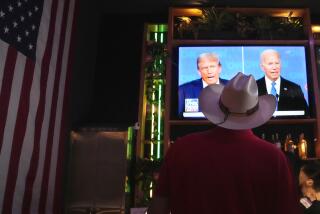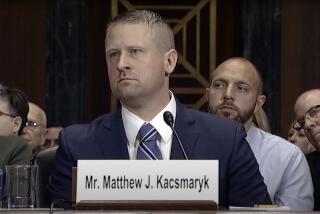Judge Finds Humility in Journey From Housing Projects to Bench
- Share via
NEW YORK — Though it’s sometimes painful to look back on her childhood in the South Bronx housing projects--the drab kitchen, the drug dealers lurking in stairwells--Judge Sonia Sotomayor finds much to treasure on her long path to the nation’s second-highest court.
“Your childhood environment shapes your perceptions, your character, your sense of values,” says Sotomayor, who was appointed to the 2nd U.S. Circuit Court of Appeals in October.
“To the extent that I lived in an environment wrought with poverty and the mixture of responses to it, I had perhaps a much more complex understanding of human nature.”
Her appointment to the appeals court in New York came after an 18-month delay in the congressional approval process--the latest obstacle for a woman used to persevering.
She says it was laughter that helped her survive a childhood in the project buildings and helped her deal with juvenile diabetes, for which she has taken insulin shots since age 8.
To the public, the 44-year-old judge is best known for a spring day in 1995 when she presided over a hearing that resurrected baseball from the ashes of its crippling strike.
But her own mind goes back to a different day of decision: when she signed her first judgment of conviction, alone in her office sending a drug offender to prison.
“That emotion will never leave me--humility, a deep, deep sense of humility,” she says. “And a deep, deep sense of, ‘There but for the grace of God could I have gone and many that I have loved.’ ”
Finding Inspiration on ‘Perry Mason’
As a child in the projects-- where she found she could avoid most danger simply by staying out of the stairwells--she buried herself in Nancy Drew books and spent hours watching “Perry Mason” on television, forming a passion for the law. “I’m a real product of the media age,” she says.
She first dreamed of becoming a detective, like the heroine of the novels she read, but her diabetes ruled out a physical career.
One “Perry Mason” episode, ending with the camera fixed on the judge, helped shape her career goal before she was 10. “I realized that the judge was the most important player in that room,” she says.
The judge, who has a round face and hair the color of her black judicial robe, speaks bluntly, with flashes of emotion alternating with introspection.
Her parents were born in Puerto Rico, and her father, a tool-and-die maker, died when she was 9. Her mother, a nurse, always kept a pot of rice and beans on the stove. Sotomayor and her brother, who became a doctor, had plenty of hungry friends.
Their mother was strict about homework and courtesy and encouraged them to make their own choices.
“Education for her was paramount,” the judge recalls. “When the encyclopedia salesman came to the door, we were the only kids in the neighborhood who got the encyclopedias.”
As drugs became an increasing menace in the Bronx projects, her family moved away, though the old neighborhood has stayed with her.
“There were working poor in the projects. There were poor poor in the projects. There were sick poor in the projects. There were addicts and nonaddicts and all sorts of people, every one of them with problems, and each group with a different response, different methods of survival, different reactions to the adversity they were facing,” she says. “And you saw kids making choices.”
Her choice was to study hard. She graduated summa cum laude from Princeton, then became an editor of the Yale Law Journal at Yale Law School. She then joined the Manhattan district attorney’s office and the board of the Puerto Rican Legal Defense and Education Fund.
After five years as a prosecutor, she joined the Midtown law firm of Pavia & Harcourt with the understanding that she would broaden her experience with commercial litigation and then return to public service. She was there eight years.
Eclectic Tastes, an Intense Mien
In 1992 she was appointed a federal district judge.
Among her rulings, she advanced 1st Amendment religious claims by overturning a state prison rule banning members of a religious sect from wearing colored beads that had spiritual meaning, and by striking down a law preventing the display of a 9-foot-high menorah in a town park in White Plains.
In 1995, she released the suicide note of former White House aide Vincent Foster, acting on litigation brought by the Wall Street Journal under the Freedom of Information Act.
With her appointment to the 2nd Circuit, Sotomayor joins a longtime friend, Judge Jose A. Cabranes, who met her at Yale.
“She was then and she is now sparkling bright and aggressive in the pursuit of knowledge,” Cabranes says. “She was unusually self-confident for a law student. She was never one to be overwhelmed, as so many of us were in the first year of law school.”
Her newest judicial role removes her from the raw emotions she saw between litigants, leaving her to weigh lawyers’ quarrels over sometimes arcane legal points. Nonetheless, she notes, “the papers that are submitted on appeal are not voiceless.”
In a self-analysis reluctantly given, Sotomayor calls herself “extraordinarily intense” but “very fun-loving.” Her intensity can intimidate people, as it did the paralegal who broke out in hives each time she faced her.
“It takes people a little bit of time to realize that I’m not forbidding,” she says.
Her tastes range from ballet to baseball, from the Four Seasons to the hot dog stand on the corner. “I have beer and champagne tastes,” she says, smiling.
The champagne remained on ice for 18 months while her nomination to the appeals court languished, reportedly because of concerns by Republicans that she might someday be considered for the Supreme Court.
Sen. Patrick Leahy, a member of the Senate Judiciary Committee, told the Senate on Oct. 2 that Sotomayor’s rulings “followed the law” and “there is no basis for a charge that she is or will be a judicial activist.” The vote that day went in her favor, 68-28.
Remaining Mum on Ambitions for Future
Says Sotomayor now: “I don’t think anybody looked at me as a woman or as a Hispanic and said, ‘We’re not going to appoint her because of those characteristics.’ Clearly that’s not what occurred.
“But I do believe there are gender and ethnic stereotypes that propel people to assumptions about what they expected me to be,” she continues.
Speaking like the jurist she is, she says the discussion was a good thing: “So long as people of goodwill are participating in the process and attempting to be balanced in their approach, then the system will remain healthy.”
Sotomayor will not say whether she wants to be on the Supreme Court. The 2nd Circuit is what she applied for, she says, and where she wants to be.
In November, when she was sworn in, she hugged and kissed each member of the appeals court and told the story of her immigrant mother’s struggle to give her children a better life. Her mother sat proudly, wiping tears.
More to Read
Sign up for Essential California
The most important California stories and recommendations in your inbox every morning.
You may occasionally receive promotional content from the Los Angeles Times.













